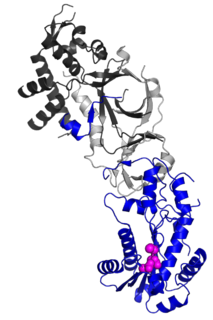Cytoplasmic FMR1-interacting protein 1 is a protein that in humans is encoded by the CYFIP1 gene. [5] [6]
Cytoplasmic FMR1-interacting protein 1 is a protein that in humans is encoded by the CYFIP1 gene. [5] [6]
CYFIP1 has been shown to interact with FMR1, [5] to the exclusion of FXR1 and FXR2. [5] It also forms part of the WAVE regulatory complex (WRC), [7] and based on the crystal structure of the WRC it is believed CYFIP1 provides the binding site for the complex to Rac1. [8]

Fragile X mental retardation syndrome-related protein 1 is a protein that in humans is encoded by the FXR1 gene.

Cytoplasmic FMR1-interacting protein 2 is a protein that in humans is encoded by the CYFIP2 gene. Cytoplasmic FMR1 interacting protein is a 1253 amino acid long protein and is highly conserved sharing 99% sequence identity to the mouse protein. It is expressed mainly in brain tissues, white blood cells and the kidney.

Phosducin-like protein is a protein that in humans is encoded by the PDCL gene.

Large proline-rich protein BAT2 is a protein that in humans is encoded by the BAT2 gene.

Rho GTPase-activating protein 4 is an enzyme that in humans is encoded by the ARHGAP4 gene. It has been shown to regulate cell motility and axonal outgrowth in vitro.

Chromatin modification-related protein MEAF6 is a protein that in humans is encoded by the MEAF6 gene.

Olfactory receptor 2F1 is a protein that in humans is encoded by the OR2F1 gene.

Olfactory receptor 2C3 is a protein that in humans is encoded by the OR2C3 gene.

Olfactory receptor 5V1 is a protein that in humans is encoded by the OR5V1 gene.

Transcriptional activator protein Pur-beta is a protein that in humans is encoded by the PURB gene.

SLIT-ROBO Rho GTPase-activating protein 3 is an enzyme that in humans is encoded by the SRGAP3 gene.

Protein phosphatase Slingshot homolog 2 is an enzyme that in humans is encoded by the SSH2 gene.

Kinetochore-associated protein NSL1 homolog is a protein that in humans is encoded by the NSL1 gene.

Amyloid protein-binding protein 2 is a protein that in humans is encoded by the APPBP2 gene.

KANSL3, or KAT8 regulatory NSL complex subunit 3 is a protein that in humans is encoded by the KANSL3 gene.

Protein phosphatase 1 regulatory subunit 14C is an enzyme that in humans is encoded by the PPP1R14C gene.

Zinc finger and BTB domain-containing protein 40 is a protein that in humans is encoded by the ZBTB40 gene.

Ribonuclease H2 subunit A, also known as RNase H2 subunit A, is an enzyme that in humans is encoded by the RNASEH2A gene.

Lysosomal thioesterase PPT2 (PPT-2), also known as S-thioesterase G14, is an enzyme that in humans is encoded by the PPT2 gene.

High mobility group nucleosome-binding domain-containing protein 4 is a transcription factor that in humans is encoded by the HMGN4 gene.